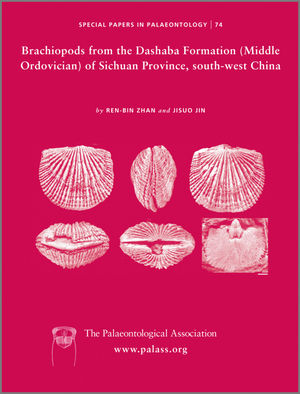Reg. Charity No. 1168330

The Middle Ordovician Dashaba Formation in southern Sichuan Province, China, a 50-m-thick succession of calcareous and silty mudstones with calcareous nodules and limestone lenses, contains a rich, diverse, brachiopod fauna; 19 genera and 20 species are represented by 3018 specimens (1257 individuals). Four genera (Heteromena, Leptastichidia, Parisorthis and Pentagomena) and six species (Glyptomena? rugulosa, Heteromena dorsiconversa, Leptastichidia catatonosis, Parisorthis dischidanteris, Pentagomena parvicostellata and Triotechia chuannanensis) are new. Graptolites from the Dashaba Formation indicate the presence of four graptolite biozones: in ascending order, the uppermost part of the Undulograptus austrodentatus, the U. intersitus, the Didymograptus artus and the D. murchisoni biozones, which range from latest Arenig to Llanvirn in age. Despite the relatively homogeneous lithology, cluster analysis indicates that the brachiopod fauna of the Dashaba Formation can be divided into five associations: the Parisorthis dischidanteris, Saucrorthis obscura, Saucrorthis obscura-Parisorthis dischidanteris, Orthambonites delicata- Pentagomena parvicostellata and Calyptolepta chengkouensis associations. Faunal differentiation may have been the result of subtle changes in water depth (between BA2 and BA3 settings) and ⁄ or reflect the variable ratios in the supply of siliciclastic mud, quartz silt and carbonate mud. The variation in sediments would have affected the substrate softness and stability, which, in turn, probably controlled the distribution of fixosessile or librosessile brachiopods.